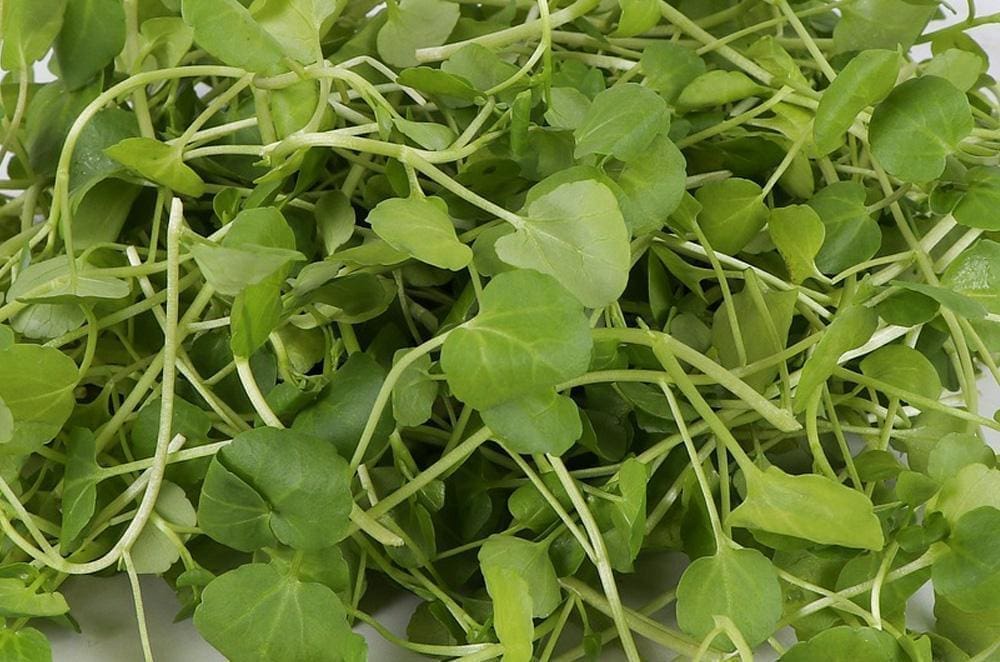Watercress is one of the most underrated greens you can grow at home. Known for its sharp, peppery bite and dense nutritional profile, it has been enjoyed for centuries in salads, soups, sandwiches, and even smoothies. This leafy green is more than just a garnish — it is one of the most nutrient-rich foods in the world, loaded with vitamins A, C, and K, plus calcium and iron. Adding watercress to your diet can boost flavour while supporting your overall health.
Quick Start (Kratky in 7 Steps)
- Container: Use an opaque tub or bucket with a tight lid.
- Cut holes: Fit 5–7 cm net pots in the lid.
- Medium: Fill pots with rockwool, clay pebbles, or coco coir.
- Solution: Add hydroponic nutrients to clean water. pH 6.5–7.5.
- Water line: Set the level to touch each net pot base.
- Seeds/seedlings: Sow in cubes or transplant small starts.
- Light: Give 4–6 hours of gentle sun or use LED grow lights.
What Is the Kratky Method?
The Kratky method is passive hydroponics. No pumps. No electricity. Plants sit above a nutrient solution. As they drink, the water level drops. An air gap forms and feeds roots with oxygen. This balance keeps growth steady and strong.
- Low maintenance: Few parts. Few checks.
- Cost effective: Simple gear and easy setup.
- Water smart: Uses far less water than soil.
- Space friendly: Fits balconies, benches, and windowsills.
Why Watercress Loves Kratky
Watercress (Nasturtium officinale) thrives in moist, nutrient-rich settings. Kratky copies that feel. Roots get oxygen and food at once. Growth is fast and tidy.
- Shallow roots suit net pots.
- Constant moisture supports rapid leaf growth.
- Ready in 4–6 weeks in most homes.
- High yields in small containers.

Detailed Setup Guide
1) Choose and Prepare the Container
- Pick 10–20 L opaque plastic to block light and reduce algae.
- Cut snug holes for net pots in the lid.
- Rinse parts before use.
2) Mix the Nutrient Solution
- Use a leafy-greens hydroponic nutrient.
- Target pH: 6.5–7.5.
- Target EC: 1.2–1.8 mS/cm for seedlings and vegetative growth.
- Stir well. Check pH again after 10 minutes. Adjust if needed.
3) Load Net Pots and Plant
- Pre-soak rockwool cubes in pH-balanced water.
- Place one cube per pot. Add seeds on the surface. Watercress seeds need light.
- Alternatively, transplant small seedlings with gentle roots.
4) Set the Water Line
- Raise the solution to touch the net pot base.
- As roots grow, an air gap forms. Keep it. It oxygenates the roots.
5) Position and Light
- Give bright, indirect light. Morning sun is ideal.
- Indoors, use LED grow lights for 12–14 hours daily.
- Avoid harsh afternoon heat. Shade helps in summer.
Care and Weekly Routine
- Water level: Check weekly. Top up with plain water to maintain an air gap.
- Solution life: Refresh every 3–4 weeks, or sooner if growth slows.
- Cleanliness: Wipe lids and rims. Keep light out of the reservoir.
- Temperature: Best growth at 10–22 °C. Hot spells can cause bolting.
Nutrients at a Glance
- Stage: Vegetative only (no fruiting phase).
- Focus: Ample nitrogen, plus calcium and magnesium.
- pH: 6.5–7.5. Adjust with food-safe acids or bases.
- EC: 1.2–1.8 mS/cm. Start low with young seedlings.
Kratky vs Other Growing Methods
| Method | Setup | Maintenance | Water Use | Best For |
|---|---|---|---|---|
| Kratky | Very simple | Low | Very efficient | Beginners, small spaces |
| Soil | Basic | Medium (watering, weeds) | High | Outdoor beds |
| NFT | Complex (pumps, channels) | High | Efficient | Advanced users, commercial |
| DWC | Moderate (air pumps) | Medium | Efficient | Intermediate hydroponics |
Harvest and Storage
- Harvest in 4–6 weeks when leaves reach 5–7 cm.
- Cut above the net pot. Do not remove all growth points.
- Rinse, dry, and chill.
- Wrap in a damp towel and store in a sealed container for up to a week.
Troubleshooting
- Yellow leaves: Refresh nutrients. Check EC and pH.
- Algae: Light is entering the tank. Opaque walls fix it.
- Slow growth: Add light. Confirm temperature. Re-balance pH.
- Pests (aphids, snails): Use neem spray. Rinse leaves. Add barriers.
- Bolting: Heat stress. Move to shade. Harvest sooner.
Safety and Taste Tips
- Use clean, food-grade containers and tools.
- Change solution on schedule for crisp texture.
- Harvest often. Young leaves taste milder and sweeter.
Conclusion
The Kratky method makes watercress simple and reliable. Setup is quick. Care is light. Yields are strong. With a small container and a little light, you can enjoy fresh, peppery greens year-round.
Click HERE to view an in-depth video on how to grow Watercress with the Kratky Method.
Buy your own Watercress Herb Seeds here and start your own Kratky journey 🛒.


